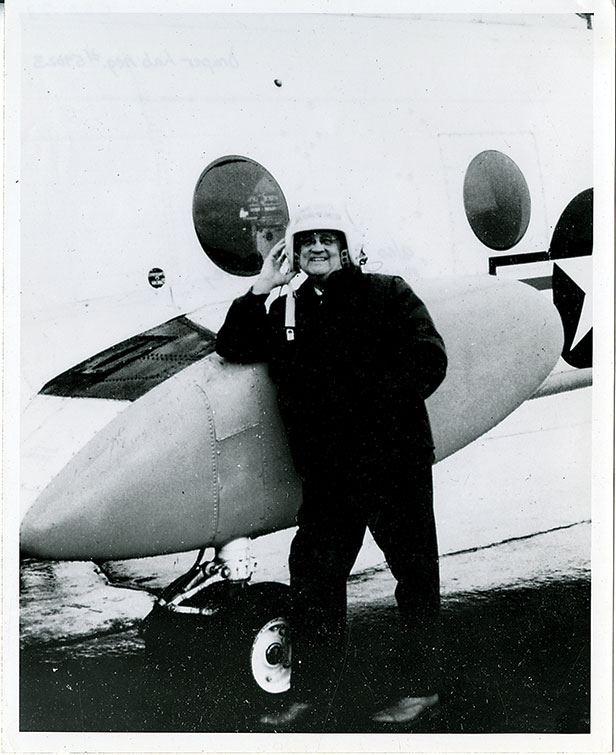
On May 25, 1961, President John F. Kennedy laid out a vision for “landing a man on the moon and returning him safely to Earth.” Six months later, Charles Stark Draper ‘26, SM ‘28, ScD ‘38, founder and director of the MIT Instrumentation Laboratory (now the Charles Stark Draper Laboratory), volunteered his services for that mission. In a letter to NASA associate administrator Robert Seamans Jr., SM ‘42, ScD ‘51—his former graduate student—“Doc,” as Draper was affectionately known, wrote:
I realize that my age of 60 years is a negative factor in considering my request, but … I will gladly undergo any physical examinations and tests that may be prescribed and will take any courses of training that may be recommended.
Seamans respectfully declined the request, and Draper, who was then building the navigational system for the Apollo spacecraft, never traveled to space. But he remained tireless in championing his technologies. This past May, in recognition of his many innovations in space navigation, the Department of Aeronautics and Astronautics sent Draper’s letter into orbit with astronaut Greg Chamitoff, PhD ‘92, on the space shuttle Endeavor’s final mission.
“This document reminds us of the enormous contributions made by Charles Stark Draper to the American space program,” says Deborah Douglas, curator of science and technology at the MIT Museum. It also reflects Draper’s gung-ho approach to technology.
Draper, a former boxer, was “gregarious, energetic, enthusiastic, ambitious, and aggressive—a type-A-to-the-max, go-everywhere, try-everything, stand-on-the-frontline kind of guy,” Douglas says. He was famous for his intense attachment to his inventions, often putting himself at risk while testing new systems or proving a technical point.
In the early 1930s, when he was not yet a full professor at MIT, Draper passed a civilian flying course and bought himself a plane. He quickly identified a potential project: aviation controls of the day were sorely in need of upgrading. To make his case, he took Jay Stratton, a physics professor who later became president of MIT, for a test ride, dipping and stalling the plane over Boston’s Outer Harbor to demonstrate the instruments’ shortcomings. Stratton was duly convinced—and vowed never to fly with Draper again.
Draper’s intense faith in his technologies carried over into his work in inertial navigation, a field he founded during his time at MIT. Using gyroscopes and accelerometers, inertial navigation enables aircraft, ships, submarines, and guided missiles to find their targets without human intervention.
Although Draper’s inertial-navigation work was classified at first, the Air Force permitted him to make it public in the late 1950s. And in 1958, he was accompanied by Eric Sevareid of CBS News in a nationally televised flight across the United States in a B-29 equipped with his navigation system.
Three years later, as the United States began racing the Soviet Union to establish the first human presence on the moon, Draper and his team at MIT were awarded the first NASA contract to build a navigation and guidance system for the Apollo spacecraft. The task was monumental: the team would have to design a system that could anticipate the orbital forces of Earth and the moon, plot a trajectory that would deposit a space vehicle precisely on the lunar surface, and then enable the astronauts to return. His offer to fly with the system he created was perhaps the ultimate vote of confidence in his own work. In his letter to NASA, he wrote:
We at the Instrumentation Laboratories are going full throttle on the Apollo guidance work … If I am willing to hang my life on our equipment, the whole project will surely have the strongest possible motivation.
Although Draper’s bid was denied, the letter’s bold spirit may have fueled innovation within his lab. Douglas says, “This is one important way he motivated his team and his lab: by saying, ‘I’m going to take that risk. It’s not an abstraction, it’s not somebody else—it’s me you’re designing this system for.’ ”
By the time Draper died, in 1987, the navigation, control, and guidance systems he developed had shepherded numerous vehicles into space. They have steered the space shuttle and the International Space Station as well as ships, submarines, and missiles.
“[The letter] reminds us that there are people behind all of this stuff,” Douglas says. “The guidance systems on the shuttle and on the International Space Station bear Doc’s fingerprints. Even if he didn’t ever get to fly as an astronaut, he’s there.”
Keep Reading
Most Popular
Large language models can do jaw-dropping things. But nobody knows exactly why.
And that's a problem. Figuring it out is one of the biggest scientific puzzles of our time and a crucial step towards controlling more powerful future models.
The problem with plug-in hybrids? Their drivers.
Plug-in hybrids are often sold as a transition to EVs, but new data from Europe shows we’re still underestimating the emissions they produce.
Google DeepMind’s new generative model makes Super Mario–like games from scratch
Genie learns how to control games by watching hours and hours of video. It could help train next-gen robots too.
How scientists traced a mysterious covid case back to six toilets
When wastewater surveillance turns into a hunt for a single infected individual, the ethics get tricky.
Stay connected
Get the latest updates from
MIT Technology Review
Discover special offers, top stories, upcoming events, and more.